Roles of Dkk2 in the Linkage from Muscle to Bone during Mechanical Unloading in Mice
Abstract
:1. Introduction
2. Results
2.1. Microarray Analyses
2.2. Effects of HU and Hypergravity on Dkk2 in the Skeletal Muscle of Mice
2.3. Effects of Shear Stress on Dkk2 Expression in Muscle Cells in Vitro
2.4. Effects of HU and Hypergravity on Serum Dkk2 Levels
2.5. Correlations between Dkk2 Levels and Bone Parameters during Mechanical Unloading
2.6. Effects of Dkk2 on Muscle Cells
2.7. Effects of Dkk2 on Bone Cells
3. Discussion
4. Materials and Methods
4.1. Materials
4.2. Hindlimb Unloading Experiments
4.3. Hypergravity Experiments
4.4. Microarray Analyses
4.5. Real-Time Polymerase Chain Reaction (PCR)
4.6. Western Blot Analysis
4.7. Blood Chemistry
4.8. Quantitative Computed Tomography (QCT) Analysis
4.9. Cell Culture
4.10. Fluid Flow Shear Stress (FFSS)
4.11. Preparation of Primary Osteoblasts
4.12. ALP Activity
4.13. Mineralization of Calvarial Osteoblasts
4.14. Osteoclast Formation
4.15. Statistical Analysis
Supplementary Materials
Author Contributions
Funding
Conflicts of Interest
References
- Kawao, N.; Kaji, H. Interactions between muscle tissues and bone metabolism. J. Cell Biochem. 2015, 116, 687–695. [Google Scholar] [CrossRef] [PubMed]
- Kaji, H. Effects of myokines on bone. Bonekey Rep. 2016, 5, 826. [Google Scholar] [CrossRef] [PubMed]
- Kawao, N.; Morita, H.; Obata, K.; Tatsumi, K.; Kaji, H. Role of follistatin in muscle and bone alterations induced by gravity change in mice. J. Cell Physiol. 2018, 233, 1191–1201. [Google Scholar] [CrossRef]
- Kawao, N.; Moritake, A.; Tatsumi, K.; Kaji, H. Roles of irisin in the linkage from muscle to bone during mechanical unloading in mice. Calcif. Tissue Int. 2018, 103, 24–34. [Google Scholar] [CrossRef]
- Baron, R.; Kneissel, M. WNT signaling in bone homeostasis and disease: from human mutations to treatments. Nat. Med. 2013, 19, 179–192. [Google Scholar] [CrossRef] [PubMed]
- Cosman, F.; Crittenden, D.B.; Adachi, J.D.; Binkley, N.; Czerwinski, E.; Ferrari, S.; Hofbauer, L.C.; Lau, E.; Lewiecki, E.M.; Miyauchi, A.; et al. Romosozumab treatment in postmenopausal women with osteoporosis. N. Engl. J. Med. 2016, 375, 1532–1543. [Google Scholar] [CrossRef] [PubMed]
- Li, J.; Sarosi, I.; Cattley, R.C.; Pretorius, J.; Asuncion, F.; Grisanti, M.; Morony, S.; Adamu, S.; Geng, Z.; Qiu, W.; et al. Dkk1-mediated inhibition of Wnt signaling in bone results in osteopenia. Bone 2006, 39, 754–766. [Google Scholar] [CrossRef]
- Colditz, J.; Thiele, S.; Baschant, U.; Niehrs, C.; Bonewald, L.F.; Hofbauer, L.C.; Rauner, M. Postnatal skeletal deletion of Dickkopf-1 increases bone formation and bone volume in male and female mice, despite increased sclerostin expression. J. Bone Miner. Res. 2018, 33, 1698–1707. [Google Scholar] [CrossRef] [Green Version]
- Mukhopadhyay, M.; Shtrom, S.; Rodriguez-Esteban, C.; Chen, L.; Tsukui, T.; Gomer, L.; Dorward, D.W.; Glinka, A.; Grinberg, A.; Huang, S.P.; et al. Dickkopf1 is required for embryonic head induction and limb morphogenesis in the mouse. Dev. Cell 2001, 1, 423–434. [Google Scholar] [CrossRef] [Green Version]
- Morvan, F.; Boulukos, K.; Clement-Lacroix, P.; Roman Roman, S.; Suc-Royer, I.; Vayssiere, B.; Ammann, P.; Martin, P.; Pinho, S.; Pognonec, P.; et al. Deletion of a single allele of the Dkk1 gene leads to an increase in bone formation and bone mass. J. Bone Miner. Res. 2006, 21, 934–945. [Google Scholar] [CrossRef]
- Tian, E.; Zhan, F.; Walker, R.; Rasmussen, E.; Ma, Y.; Barlogie, B.; Shaughnessy, J.D., Jr. The role of the Wnt-signaling antagonist DKK1 in the development of osteolytic lesions in multiple myeloma. N. Engl. J. Med. 2003, 349, 2483–2494. [Google Scholar] [CrossRef] [PubMed]
- Rauner, M.; Thiele, S.; Sinningen, K.; Winzer, M.; Salbach-Hirsch, J.; Gloe, I.; Peschke, K.; Haegeman, G.; Tuckermann, J.P.; Hofbauer, L.C. Effects of the selective glucocorticoid receptor modulator compound A on bone metabolism and inflammation in male mice with collagen-induced arthritis. Endocrinology 2013, 154, 3719–3728. [Google Scholar] [CrossRef] [PubMed] [Green Version]
- Wang, F.S.; Ko, J.Y.; Yeh, D.W.; Ke, H.C.; Wu, H.L. Modulation of Dickkopf-1 attenuates glucocorticoid induction of osteoblast apoptosis, adipocytic differentiation, and bone mass loss. Endocrinology 2008, 149, 1793–1801. [Google Scholar] [CrossRef] [PubMed]
- Ahmed, S.F.; Fouda, N.; Abbas, A.A. Serum dickkopf-1 level in postmenopausal females: correlation with bone mineral density and serum biochemical markers. J. Osteoporos. 2013, 2013, 460210. [Google Scholar] [CrossRef] [PubMed] [Green Version]
- Robling, A.G.; Niziolek, P.J.; Baldridge, L.A.; Condon, K.W.; Allen, M.R.; Alam, I.; Mantila, S.M.; Gluhak-Heinrich, J.; Bellido, T.M.; Harris, S.E.; et al. Mechanical stimulation of bone in vivo reduces osteocyte expression of Sost/sclerostin. J. Biol. Chem. 2008, 283, 5866–5875. [Google Scholar] [CrossRef] [PubMed] [Green Version]
- Kotiya, A.A.; Bayly, P.V.; Silva, M.J. Short-term low-strain vibration enhances chemo-transport yet does not stimulate osteogenic gene expression or cortical bone formation in adult mice. Bone 2011, 48, 468–475. [Google Scholar] [CrossRef] [Green Version]
- Chan, T.F.; Couchourel, D.; Abed, E.; Delalandre, A.; Duval, N.; Lajeunesse, D. Elevated Dickkopf-2 levels contribute to the abnormal phenotype of human osteoarthritic osteoblasts. J. Bone Miner. Res. 2011, 26, 1399–1410. [Google Scholar] [CrossRef]
- Li, X.; Liu, P.; Liu, W.; Maye, P.; Zhang, J.; Zhang, Y.; Hurley, M.; Guo, C.; Boskey, A.; Sun, L.; et al. Dkk2 has a role in terminal osteoblast differentiation and mineralized matrix formation. Nat. Genet. 2005, 37, 945–952. [Google Scholar] [CrossRef]
- Van der Horst, G.; van der Werf, S.M.; Farih-Sips, H.; van Bezooijen, R.L.; Lowik, C.W.; Karperien, M. Downregulation of Wnt signaling by increased expression of Dickkopf-1 and -2 is a prerequisite for late-stage osteoblast differentiation of KS483 cells. J. Bone Miner. Res. 2005, 20, 1867–1877. [Google Scholar] [CrossRef]
- Li, L.; Mao, J.; Sun, L.; Liu, W.; Wu, D. Second cysteine-rich domain of Dickkopf-2 activates canonical Wnt signaling pathway via LRP-6 independently of dishevelled. J. Biol. Chem. 2002, 277, 5977–5981. [Google Scholar] [CrossRef] [Green Version]
- Chen, L.; Wang, K.; Shao, Y.; Huang, J.; Li, X.; Shan, J.; Wu, D.; Zheng, J.J. Structural insight into the mechanisms of Wnt signaling antagonism by Dkk. J. Biol. Chem. 2008, 283, 23364–23370. [Google Scholar] [CrossRef] [PubMed] [Green Version]
- Rudnicki, M.A.; Williams, B.O. Wnt signaling in bone and muscle. Bone 2015, 80, 60–66. [Google Scholar] [CrossRef] [PubMed] [Green Version]
- Tajbakhsh, S.; Borello, U.; Vivarelli, E.; Kelly, R.; Papkoff, J.; Duprez, D.; Buckingham, M.; Cossu, G. Differential activation of Myf5 and MyoD by different Wnts in explants of mouse paraxial mesoderm and the later activation of myogenesis in the absence of Myf5. Development 1998, 125, 4155–4162. [Google Scholar]
- Munsterberg, A.E.; Kitajewski, J.; Bumcrot, D.A.; McMahon, A.P.; Lassar, A.B. Combinatorial signaling by Sonic hedgehog and Wnt family members induces myogenic bHLH gene expression in the somite. Genes Dev. 1995, 9, 2911–2922. [Google Scholar] [CrossRef] [PubMed] [Green Version]
- Otto, A.; Schmidt, C.; Luke, G.; Allen, S.; Valasek, P.; Muntoni, F.; Lawrence-Watt, D.; Patel, K. Canonical Wnt signalling induces satellite-cell proliferation during adult skeletal muscle regeneration. J. Cell Sci. 2008, 121, 2939–2950. [Google Scholar] [CrossRef] [Green Version]
- Murphy, M.M.; Keefe, A.C.; Lawson, J.A.; Flygare, S.D.; Yandell, M.; Kardon, G. Transiently active Wnt/β-catenin signaling is not required but must be silenced for stem cell function during muscle regeneration. Stem Cell Rep. 2014, 3, 475–488. [Google Scholar] [CrossRef] [Green Version]
- Kawao, N.; Morita, H.; Obata, K.; Tamura, Y.; Okumoto, K.; Kaji, H. The vestibular system is critical for the changes in muscle and bone induced by hypergravity in mice. Physiol. Rep. 2016, 4, e12979. [Google Scholar] [CrossRef]
- Juffer, P.; Jaspers, R.T.; Lips, P.; Bakker, A.D.; Klein-Nulend, J. Expression of muscle anabolic and metabolic factors in mechanically loaded MLO-Y4 osteocytes. Am. J. Physiol. Endocrinol. Metab. 2012, 302, E389–E395. [Google Scholar] [CrossRef]
- Guan, P.P.; Guo, J.W.; Yu, X.; Wang, Y.; Wang, T.; Konstantopoulos, K.; Wang, Z.Y.; Wang, P. The role of cyclooxygenase-2, interleukin-1β and fibroblast growth factor-2 in the activation of matrix metalloproteinase-1 in sheared-chondrocytes and articular cartilage. Sci. Rep. 2015, 5, 10412. [Google Scholar] [CrossRef] [Green Version]
- Mao, B.; Niehrs, C. Kremen2 modulates Dickkopf2 activity during Wnt/LRP6 signaling. Gene 2003, 302, 179–183. [Google Scholar] [CrossRef]
- Kuroda, K.; Kuang, S.; Taketo, M.M.; Rudnicki, M.A. Canonical Wnt signaling induces BMP-4 to specify slow myofibrogenesis of fetal myoblasts. Skelet. Muscle 2013, 3, 5. [Google Scholar] [CrossRef] [PubMed] [Green Version]
- Hutcheson, D.A.; Zhao, J.; Merrell, A.; Haldar, M.; Kardon, G. Embryonic and fetal limb myogenic cells are derived from developmentally distinct progenitors and have different requirements for β-catenin. Genes Dev. 2009, 23, 997–1013. [Google Scholar] [CrossRef] [PubMed] [Green Version]
- Yin, J.; Yang, L.; Xie, Y.; Liu, Y.; Li, S.; Yang, W.; Xu, B.; Ji, H.; Ding, L.; Wang, K.; et al. Dkk3 dependent transcriptional regulation controls age related skeletal muscle atrophy. Nat. Commun. 2018, 9, 1752. [Google Scholar] [CrossRef] [PubMed]
- Han, S.O.; Kommaddi, R.P.; Shenoy, S.K. Distinct roles for β-arrestin2 and arrestin-domain-containing proteins in β2 adrenergic receptor trafficking. EMBO Rep. 2013, 14, 164–171. [Google Scholar] [CrossRef] [Green Version]
- Gordon, B.S.; Rossetti, M.L.; Eroshkin, A.M. Arrdc2 and Arrdc3 elicit divergent changes in gene expression in skeletal muscle following anabolic and catabolic stimuli. Physiol. Genomics 2019, 51, 208–217. [Google Scholar] [CrossRef]
- Furlow, J.D.; Watson, M.L.; Waddell, D.S.; Neff, E.S.; Baehr, L.M.; Ross, A.P.; Bodine, S.C. Altered gene expression patterns in muscle ring finger 1 null mice during denervation- and dexamethasone-induced muscle atrophy. Physiol. Genomics 2013, 45, 1168–1185. [Google Scholar] [CrossRef] [Green Version]
- Kumar, A.; Tikoo, S.; Maity, S.; Sengupta, S.; Kaur, A.; Bachhawat, A.K. Mammalian proapoptotic factor ChaC1 and its homologues function as γ-glutamyl cyclotransferases acting specifically on glutathione. EMBO Rep. 2012, 13, 1095–1101. [Google Scholar] [CrossRef] [Green Version]
- Deloux, R.; Tannous, C.; Ferry, A.; Li, Z.; Mericskay, M. Aged nicotinamide riboside kinase 2 deficient mice present an altered response to endurance exercise training. Front. Physiol. 2018, 9, 1290. [Google Scholar] [CrossRef] [Green Version]
- Krupnik, V.E.; Sharp, J.D.; Jiang, C.; Robison, K.; Chickering, T.W.; Amaravadi, L.; Brown, D.E.; Guyot, D.; Mays, G.; Leiby, K.; et al. Functional and structural diversity of the human Dickkopf gene family. Gene 1999, 238, 301–313. [Google Scholar] [CrossRef]
- Niehrs, C. Function and biological roles of the Dickkopf family of Wnt modulators. Oncogene 2006, 25, 7469–7481. [Google Scholar] [CrossRef] [Green Version]
- Vervloet, M.G.; Massy, Z.A.; Brandenburg, V.M.; Mazzaferro, S.; Cozzolino, M.; Urena-Torres, P.; Bover, J.; Goldsmith, D. Bone: a new endocrine organ at the heart of chronic kidney disease and mineral and bone disorders. Lancet. Diabetes Endocrinol. 2014, 2, 427–436. [Google Scholar] [CrossRef]
- Banzrai, C.; Nodera, H.; Kawarai, T.; Higashi, S.; Okada, R.; Mori, A.; Shimatani, Y.; Osaki, Y.; Kaji, R. Impaired axonal Na+ current by hindlimb unloading: implication for disuse neuromuscular atrophy. Front. Physiol. 2016, 7, 36. [Google Scholar] [CrossRef] [PubMed] [Green Version]
- Yano, M.; Kawao, N.; Okumoto, K.; Tamura, Y.; Okada, K.; Kaji, H. Fibrodysplasia ossificans progressiva-related activated activin-like kinase signaling enhances osteoclast formation during heterotopic ossification in muscle tissues. J. Biol. Chem. 2014, 289, 16966–16977. [Google Scholar] [CrossRef] [PubMed] [Green Version]
- Ishida, M.; Kawao, N.; Okada, K.; Tatsumi, K.; Sakai, K.; Nishio, K.; Kaji, H. Serpina3n, dominantly expressed in female osteoblasts, suppresses the phenotypes of differentiated osteoblasts in mice. Endocrinology 2018, 159, 3775–3790. [Google Scholar] [CrossRef] [Green Version]
- Bouxsein, M.L.; Boyd, S.K.; Christiansen, B.A.; Guldberg, R.E.; Jepsen, K.J.; Muller, R. Guidelines for assessment of bone microstructure in rodents using micro-computed tomography. J. Bone Miner. Res. 2010, 25, 1468–1486. [Google Scholar] [CrossRef]
- Kawao, N.; Ishida, M.; Kaji, H. Roles of leptin in the recovery of muscle and bone by reloading after mechanical unloading in high fat diet-fed obese mice. PLoS ONE 2019, 14, e0224403. [Google Scholar] [CrossRef] [Green Version]
- Kawao, N.; Tamura, Y.; Okumoto, K.; Yano, M.; Okada, K.; Matsuo, O.; Kaji, H. Plasminogen plays a crucial role in bone repair. J. Bone Miner. Res. 2013, 28, 1561–1574. [Google Scholar] [CrossRef]
- Kawao, N.; Tamura, Y.; Okumoto, K.; Yano, M.; Okada, K.; Matsuo, O.; Kaji, H. Tissue-type plasminogen activator deficiency delays bone repair: roles of osteoblastic proliferation and vascular endothelial growth factor. Am. J. Physiol. Endocrinol. Metab. 2014, 307, E278–E288. [Google Scholar] [CrossRef] [Green Version]
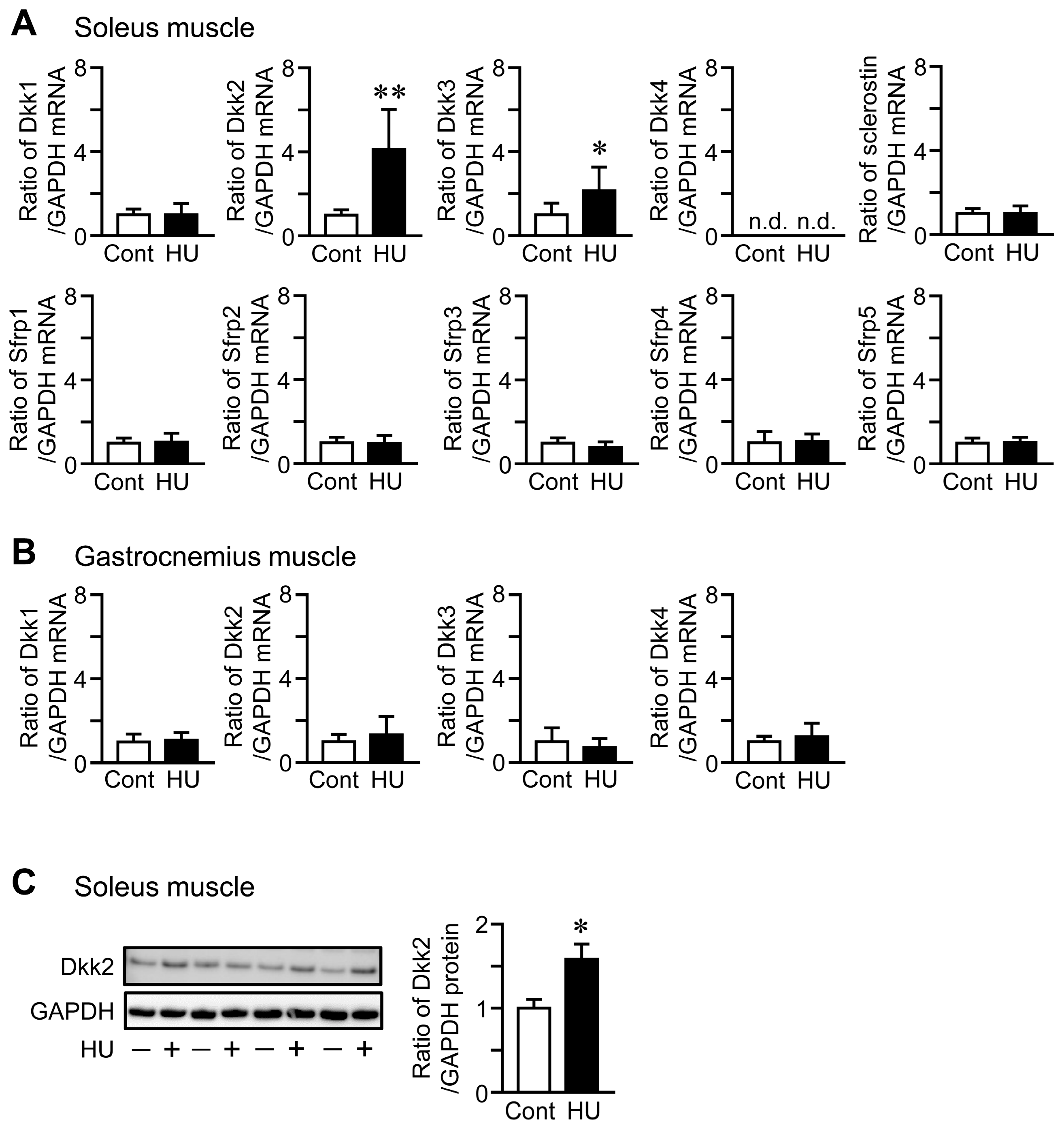

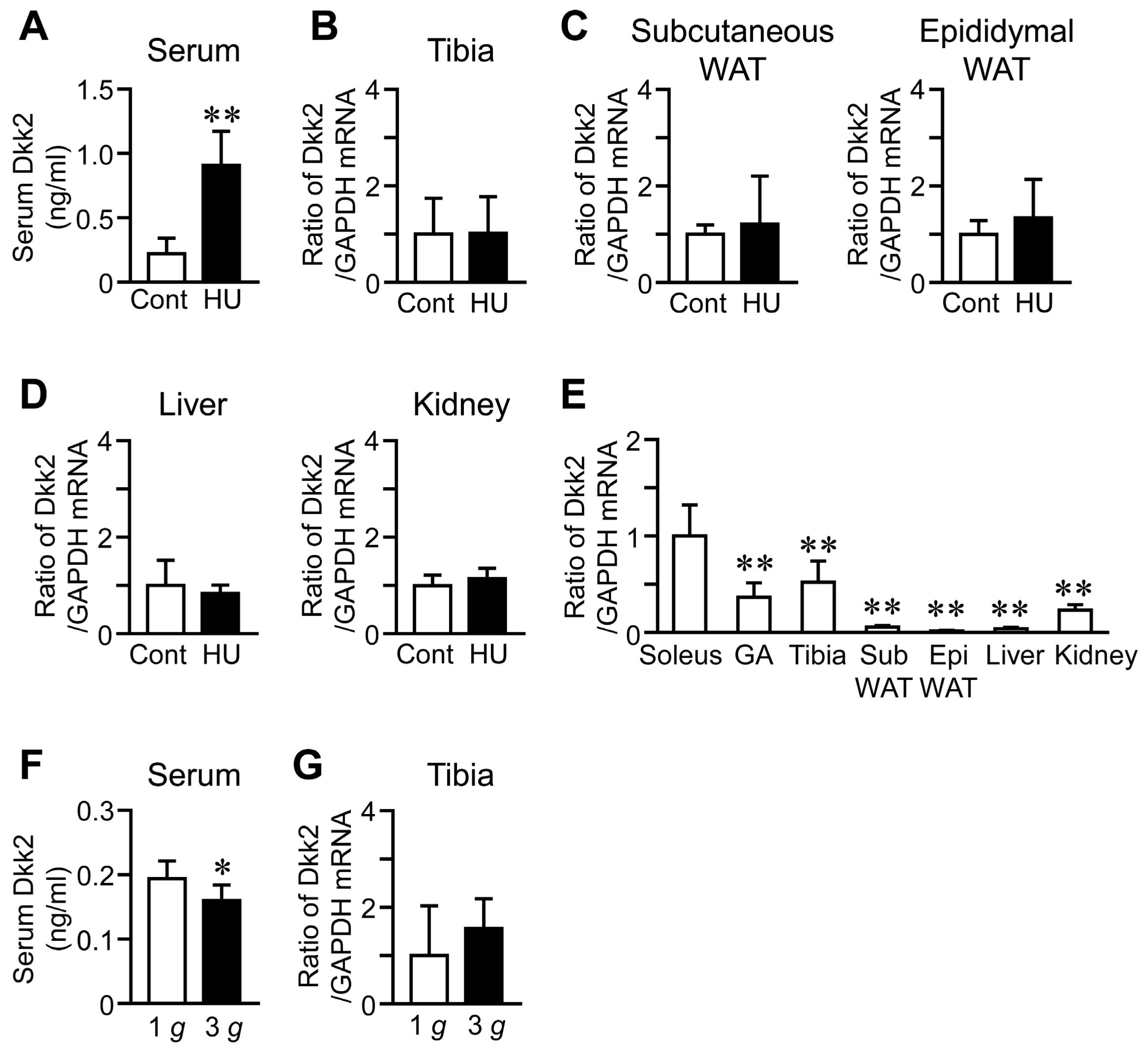
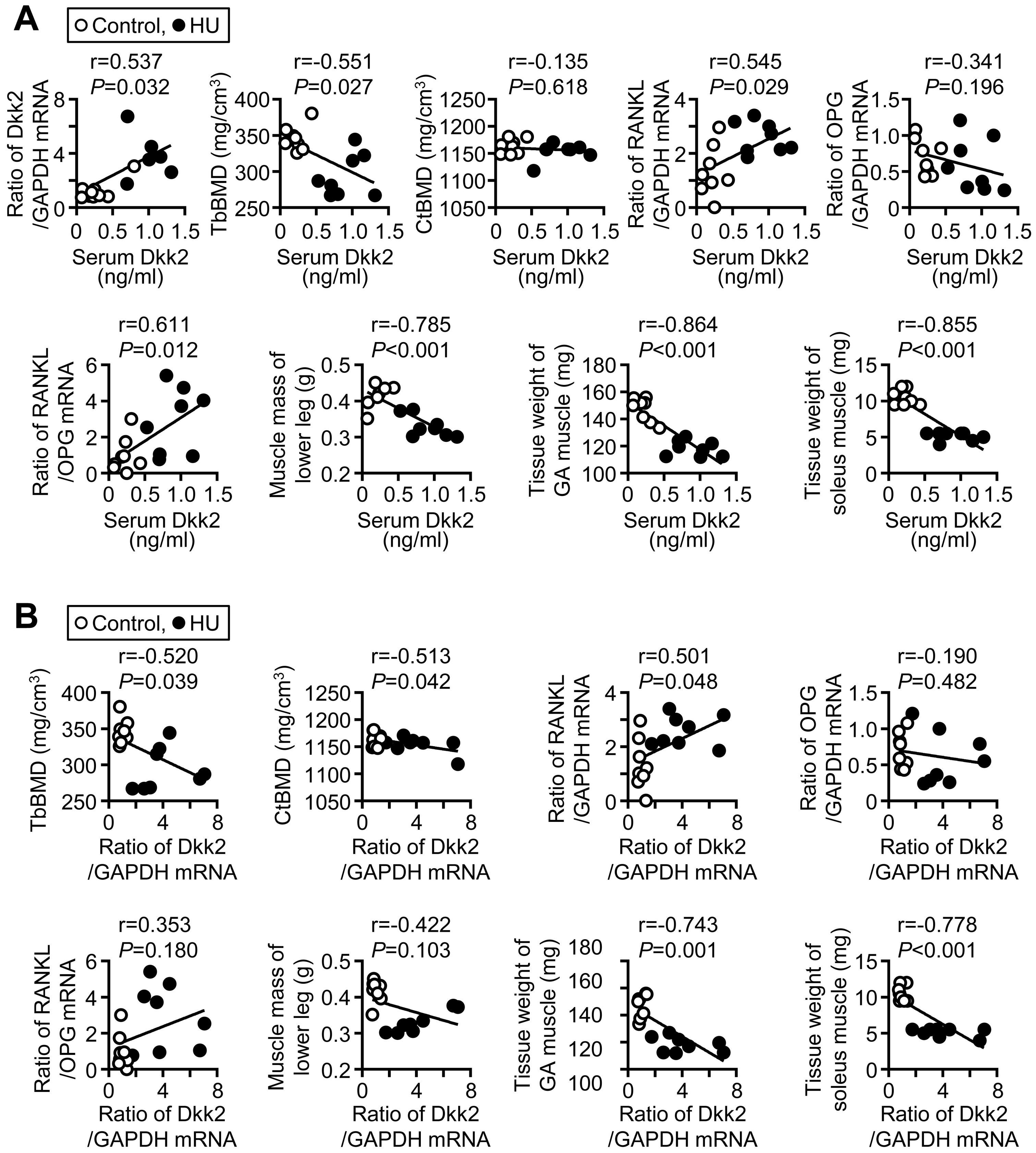
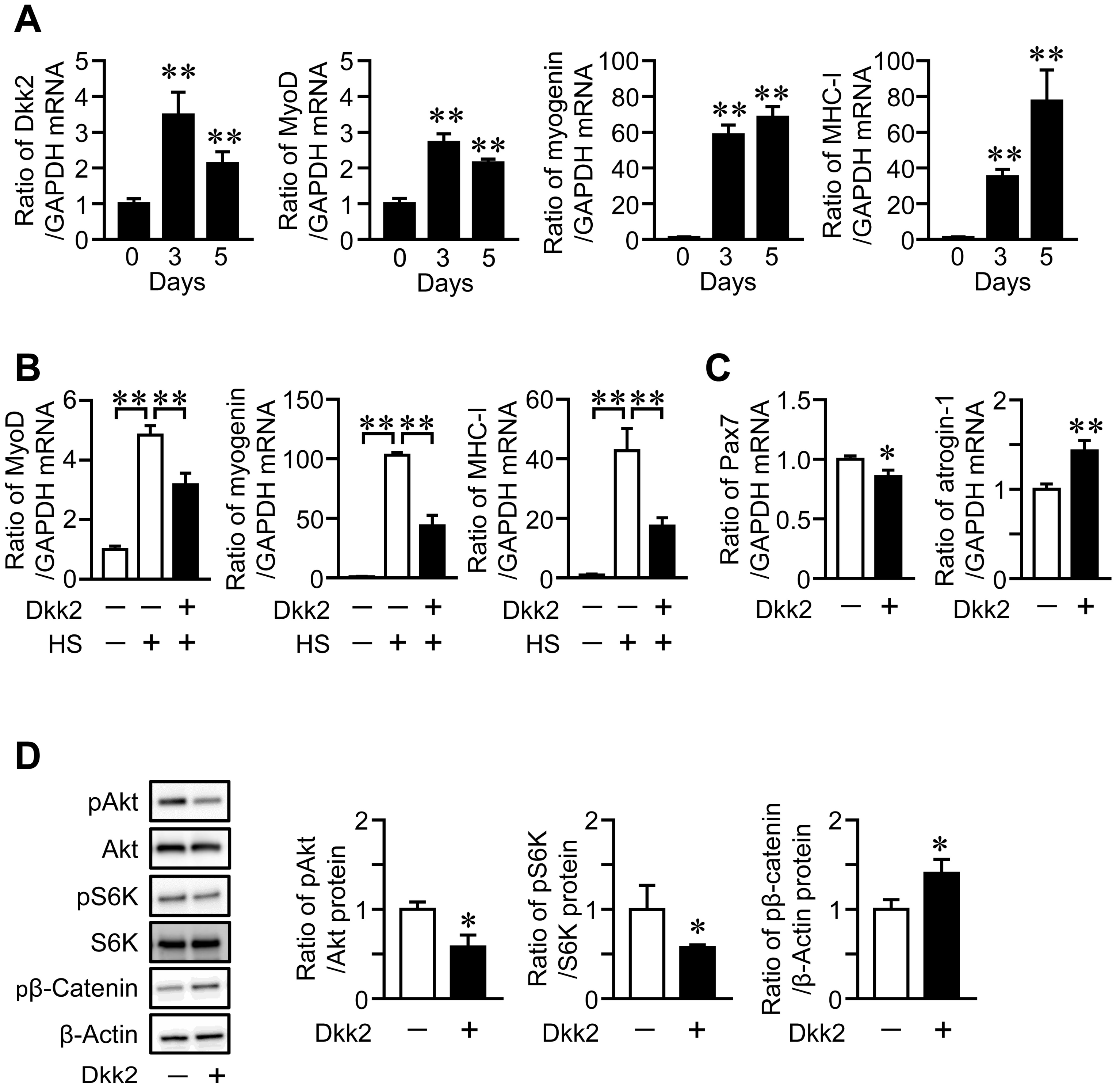
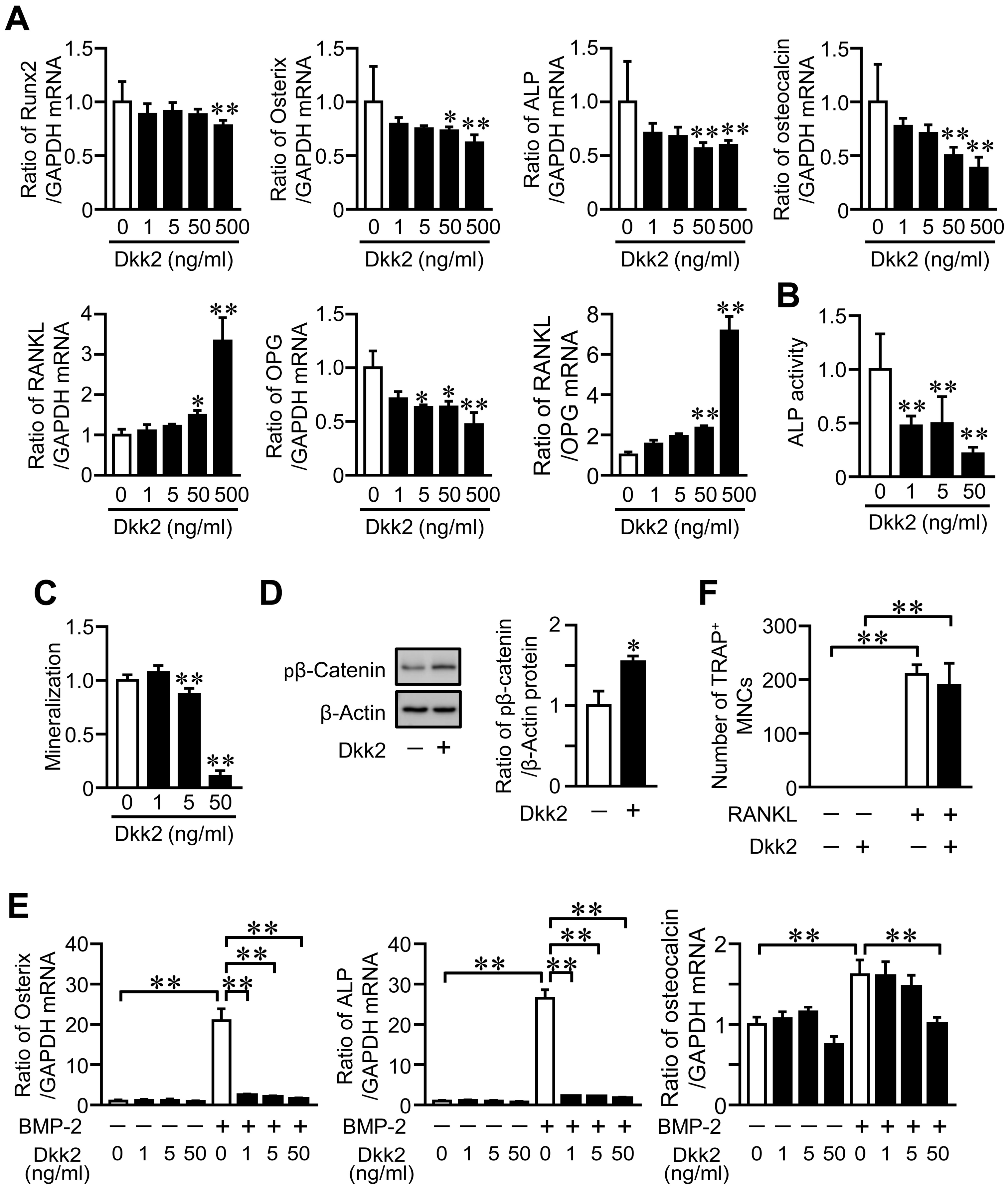
| Gene | Gene Accession Number | Fold Change | |
|---|---|---|---|
| HU (≥2.0) | 3 g (≤0.5) | ||
| Arrdc2 | NM_027560 | 111.3 | 0.3 |
| Chac1 | NM_026929 | 18.7 | 0.4 |
| Nmrk2 | NM_027120 | 13.5 | 0.4 |
| Dkk2 | NM_020265 | 13.3 | 0.2 |
| Cebpd | NM_007679 | 12.9 | 0.4 |
| Mylk4 | NM_001166030 | 11.5 | 0.3 |
| Slc25a25 | ENSMUST00000028160 | 8.1 | 0.3 |
| Mafb | NM_010658 | 7.1 | 0.4 |
| Gadd45g | NM_011817 | 6.6 | 0.4 |
| Prkag3 | NM_153744 | 6.4 | 0.4 |
| Gm3893 | NR_033506 | 6.4 | −2.1 |
| Ucp3 | NM_009464 | 3.6 | 0.5 |
| Nrip1 | NM_173440 | 3.6 | 0.5 |
| Neto2 | NM_001081324 | 3.5 | 0.5 |
| Tob2 | ENSMUST00000050467 | 3.2 | 0.3 |
| Fam78a | NM_175511 | 3.1 | 0.4 |
| 4933409K07Rik | NR_033123 | 2.9 | 0.4 |
| Gm14347 | NM_001085543 | 2.9 | 0.4 |
| Igfbp5 | NM_010518 | 2.5 | 0.5 |
| Lrrc46 | NM_027026 | 2.4 | 0.2 |
| Dusp14 | NM_019819 | 2.4 | 0.5 |
| Trim7 | NM_053166 | 2.3 | 0.5 |
| Gm14625 | XM_030251462 | 2.2 | 0.04 |
| Eid3 | NM_025499 | 2.2 | 0.14 |
| Tmem225 | NM_029379 | 2.1 | 0.2 |
| Smox | NM_001177833 | 2.1 | 0.4 |
| Gprc5c | NM_001110337 | 2.1 | 0.5 |
| Hlf | NM_172563 | 2.1 | 0.4 |
| Per2 | NM_011066 | 2.1 | 0.5 |
| Slc25a33 | NM_027460 | 2.1 | 0.5 |
| Fam107a | NM_183187 | 2.1 | 0.4 |
| Nr4a1 | NM_010444 | 2.1 | 0.3 |
| Gm3417 | NM_001123368 | 2.0 | 9 × 10−3 |
| Dnah7c | ENSMUST00000178395 | 2.0 | 0.2 |
| Gene | Gene Accession Number | Fold Change | |
|---|---|---|---|
| HU | 3 g | ||
| Dkk1 | NM_010051 | −1.0 | 0.9 |
| Dkk2 | NM_020265 | 13.3 | 0.2 |
| Dkk3 | NM_015814 | −1.2 | 0.9 |
| Dkk4 | NM_145592 | −1.1 | 2.5 |
| Sfrp1 | NM_013834 | −2.0 | 1.1 |
| Sfrp2 | NM_009144 | −1.7 | 0.8 |
| Frzb (Sfrp3) | NM_011356 | 1.3 | 0.3 |
| Sfrp4 | NM_016687 | −21.4 | 0.9 |
| Sfrp5 | NM_018780 | 2.5 | 1.9 |
| Wnt1 | NM_021279 | −1.2 | 0.7 |
| Wnt2 | NM_023653 | −1.3 | 0.7 |
| Wnt2b | NM_009520 | 1.8 | 6.1 |
| Wnt3 | NM_009521 | 1.1 | 0.3 |
| Wnt3a | NM_009522 | −1.5 | 0.3 |
| Wnt4 | NM_009523 | 3.0 | 0.9 |
| Wnt5a | NM_009524 | −1.2 | 1.1 |
| Wnt5b | NM_009525 | 1.2 | 1.5 |
| Wnt6 | NM_009526 | 1.1 | 0.9 |
| Wnt7a | NM_009527 | 1.1 | 1.1 |
| Wnt7b | NM_009528 | −1.0 | 0.7 |
| Wnt8a | NM_009290 | −1.1 | 8.6 |
| Wnt8b | NM_011720 | −1.0 | 2.3 |
| Wnt9a | NM_139298 | −1.4 | 1.1 |
| Wnt9b | NM_011719 | 1.1 | 2.6 |
| Wnt10a | NM_009518 | −1.1 | 1.1 |
| Wnt10b | NM_011718 | −1.2 | 2.3 |
| Wnt11 | NM_009519 | 1.0 | 0.9 |
| Wnt16 | NM_053116 | 1.0 | 1.1 |
© 2020 by the authors. Licensee MDPI, Basel, Switzerland. This article is an open access article distributed under the terms and conditions of the Creative Commons Attribution (CC BY) license (http://creativecommons.org/licenses/by/4.0/).
Share and Cite
Kawao, N.; Morita, H.; Iemura, S.; Ishida, M.; Kaji, H. Roles of Dkk2 in the Linkage from Muscle to Bone during Mechanical Unloading in Mice. Int. J. Mol. Sci. 2020, 21, 2547. https://doi.org/10.3390/ijms21072547
Kawao N, Morita H, Iemura S, Ishida M, Kaji H. Roles of Dkk2 in the Linkage from Muscle to Bone during Mechanical Unloading in Mice. International Journal of Molecular Sciences. 2020; 21(7):2547. https://doi.org/10.3390/ijms21072547
Chicago/Turabian StyleKawao, Naoyuki, Hironobu Morita, Shunki Iemura, Masayoshi Ishida, and Hiroshi Kaji. 2020. "Roles of Dkk2 in the Linkage from Muscle to Bone during Mechanical Unloading in Mice" International Journal of Molecular Sciences 21, no. 7: 2547. https://doi.org/10.3390/ijms21072547
APA StyleKawao, N., Morita, H., Iemura, S., Ishida, M., & Kaji, H. (2020). Roles of Dkk2 in the Linkage from Muscle to Bone during Mechanical Unloading in Mice. International Journal of Molecular Sciences, 21(7), 2547. https://doi.org/10.3390/ijms21072547





